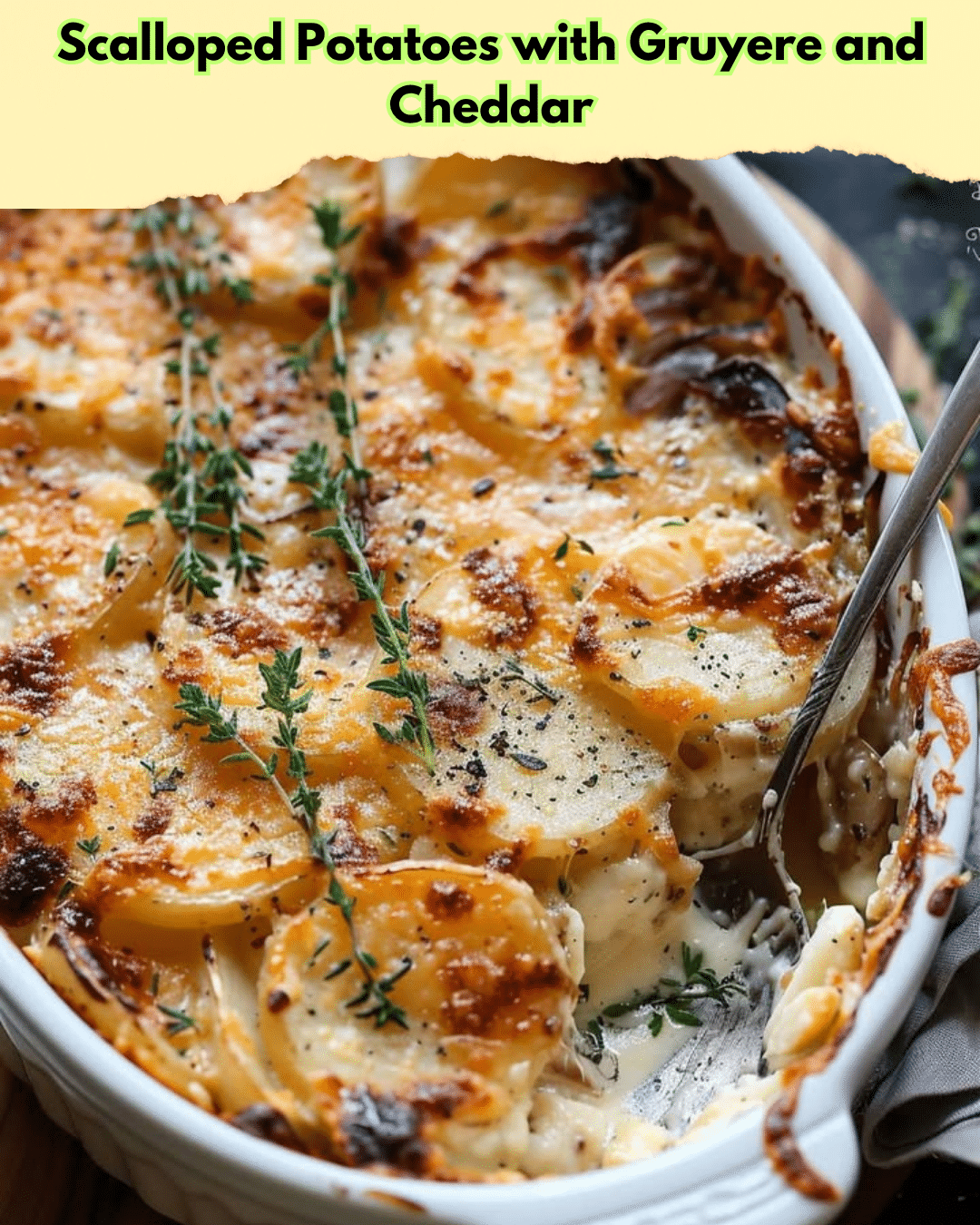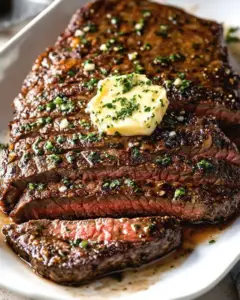Scalloped Potatoes with Gruyere and Cheddar: A Creamy Indulgence
Scalloped Potatoes with Gruyere and Cheddar is the ultimate comfort food, blending creamy, cheesy goodness with perfectly baked potatoes. This dish marries two exquisite cheeses—Gruyere and Cheddar—to create a luscious, bubbly delight. The Gruyere adds a nutty sophistication while the Cheddar brings in a sharp, tangy note. Whether serving it as a side dish to elevate your holiday spread or enjoying it as a luxurious solo indulgence, this recipe is a must-try.
Imagine slicing through the golden, cheesy crust to uncover soft layers of potatoes that have been lovingly cooked in a rich, creamy sauce. As the aroma of baked cheese and garlic fills your kitchen, you’ll be mesmerized by how such simple ingredients can result in complex flavors. Whether it’s the distinctive smokiness of the Gruyere or the comforting taste of the Cheddar, each bite promises a blend of flavors rooted in European tradition, yet inviting enough to feel like a modern classic.
Quick Recipe Highlights
- Flavor Profile: The Scalloped Potatoes with Gruyere and Cheddar boasts a rich and creamy flavor with nutty and tangy notes from the cheeses, perfectly complemented by a hint of garlic.
- Texture: Expect smooth, creamy layers of potatoes with a crunchy, golden-brown top—a perfect contrast of creamy and crispy textures.
- Aroma: The baked blend of Gruyere and Cheddar provides a savory and slightly sweet aroma with hints of nutty undertones.
- Visual Appeal: This dish is visually enticing with its golden-brown top providing a beautiful contrast to the layered, creamy potatoes beneath.
- Skill Level Needed: While it may appear gourmet, this dish is relatively simple to prepare, requiring basic slicing and layering skills.
- Special Equipment: A mandolin slicer could significantly simplify the process for achieving perfectly even potato slices, though a sharp knife will also suffice.
Recipe Overview
- Difficulty Level: While the dish involves basic culinary skills, such as slicing and preparing a roux, its complexity lies in achieving the perfect layers and ensuring that every slice is evenly cooked.
- Category: Primarily a rich side dish, scalloped potatoes serve wonderfully with roasts, but can also hold their own as a main dish.
- Cuisine: Rooted in French culinary traditions, this dish adopts an international flair with the inclusion of sharp Cheddar, adding depth and a modern twist.
- Cost: Utilizing readily available ingredients like potatoes and cheese, this dish offers gourmet results at a reasonable cost, perfect for budget-friendly indulgence.
- Season: Best enjoyed in cooler months or during festive periods when hearty dishes reign supreme, providing a warm, comforting culinary experience.
- Occasion: Ideal for holiday gatherings, family dinners, or potlucks where a show-stopping side dish is in order, drawing compliments from all around the table.
Why You’ll Love This Recipe
The taste profile of Scalloped Potatoes with Gruyere and Cheddar is where comfort and sophistication meet. The sharpness of the cheddar coupled with the creamy richness of the Gruyere elevates the humble potato into an irresistible experience. Each forkful is a delight—a unique combination of smooth, layered textures and crunchy top. Its blend of savory cheese flavors with earthy undertones from the potatoes offers a hearty, satisfying mouthfeel that’s hard to replicate.
In terms of convenience, this recipe simplifies the daunting idea of creating a gourmet-inspired dish. With easy, step-by-step preparation and minimal ingredients that are easy to find at any grocery store, it takes the guesswork out of gourmet cooking. This recipe allows you to prepare the components ahead of time, assembling the dish right before baking for utmost freshness.
Scalloped Potatoes with Gruyere and Cheddar doesn’t just satisfy your taste buds; it also delivers nutritional value. Its creamy base provides a good source of calcium and protein from the cheese, paired with the energy-rich carbohydrates of the potatoes. The inclusion of whole, natural ingredients ensures that you’re indulging in a meal free of unnecessary additives, embracing both flavor and nutrition.
Socially, it’s a recipe that brings people together. Whether as part of a communal holiday feast or a cozy family dinner, this dish enhances the camaraderie of shared dining experiences. Its established reputation as a crowd-pleaser ensures that it will be a hit with guests, making it perfect for hosting or attending potlucks.
Cost-effectiveness and the accessibility of the ingredients mean you’re creating a dish that taste extravagant without necessarily breaking the bank. Potatoes and cheese are supermarket staples, and buying in bulk can even make this an economically savvy recipe choice. Yet, despite its straightforward ingredients, the outcome is indulgent enough to feel just a little bit luxurious.
Historical Background and Cultural Significance
The origins of scalloped potatoes trace back to classical French cuisine, rooted in a history where enhancing simple ingredients was an art form. The French gratin approach was meant to elevate the most modest of components, like potatoes, into a dish of elegance and depth. This particular recipe, with its emphasis on cheese, nods to traditional French and Swiss methods of creating lavish layered bakes.
Culturally, the dish has grown beyond its origins and has been embraced worldwide. The name “scalloped potatoes” in English-speaking countries often refers to any baked potato casserole in a creamy sauce. This method of preparation spans cultures, with variations occurring in many different cuisines.
The evolution from a culinary technique to a beloved staple at tables during special occasions is notable. Modern iterations often include variations in the types of cheese used or additional ingredients, like bacon or onions, enhancing or complementing the base recipe.
Regional variations abound, demonstrating adaptation and creativity. In Switzerland, for instance, the preparation may lean more on Gruyere, reflecting local cheese production, while in Italy, you might find Parmesan or Mozzarella influences. Each culinary tradition adds its own flair to scalloped potatoes, celebrating the dish’s versatility and global appeal.
Ingredient Deep Dive
*Potatoes:* In this recipe, potatoes serve as the star ingredient, celebrated for their humble roots and nutritional benefits. High in complex carbohydrates, they provide a nourishing base that’s both filling and comforting. For this recipe, selecting starchy varieties such as Russets or Yukon Golds is preferable, as they absorb flavors well and achieve the desired creamy texture.
Storage for potatoes should be in a cool, dark place to prevent sprouting and extend shelf life. For variations, sweet potatoes could offer a unique twist, catering to those seeking a slightly different flavor profile—earthy with a touch of sweetness.
*Gruyere Cheese:* Known for its smooth melting properties and subtle saltiness, Gruyere cheese is a culinary treasure coming straight from Switzerland. It’s a hallmark of European cheese markets and adds an elegant, nutty dimension to our dish. Rich in calcium and protein, it’s a valuable addition from both a flavor and nutritional standpoint.
Store Gruyere cheese wrapped in wax paper or parchment inside an airtight container to retain its freshness. In terms of substitutions, Emmental or Comté can provide a similar texture and flavor if Gruyere is not available.
Common Mistakes to Avoid
- Overcooking the Potatoes: Avoid ending up with mushy potatoes by keeping an eye on the clock; precise cooking times ensure layers that hold their integrity.
- Uneven Slicing: Inconsistent potato slices can result in uneven cooking. Use a mandolin for uniform thickness.
- Too Little Seasoning: Remember that potatoes need adequate seasoning to bring out their natural flavors, so be generous with salt and pepper.
- Skipping the Cover: Start the baking process covered to create steam before removing the foil to brown the top layers for the last 15 minutes.
- Wrong Cheese Choice: Use cheese that melts well—Gruyere and Cheddar are ideal for their flavor and meltability.
- Not Letting Rest: Allow the dish to cool slightly after baking for easier serving and more defined layers.
- Ignoring the Sauce Consistency: Ensure the sauce is not overly thick; it should be pourable yet thick enough to coat the potatoes.
- Incorrect Baking Dish Size: Use a dish that fits the recipe volume, allowing ingredients to layer and bake evenly.
- Skipping Garlic: Garlic infuses the dish with robust flavor—don’t leave it out unless absolutely necessary.
- Wrong Potato Variety: Choose starchy potatoes like Russets for the best creamy texture.
Essential Techniques
*Creating a Roux:* A crucial step, the roux serves as the thickening base for the creamy sauce, enhancing the dish’s texture. Ensure equal parts butter and flour are cooked together until bubbling, then gradually add milk to achieve a smooth, lump-free sauce.
*Layering:* Even layering is essential for uniform cooking. Begin with a thin layer of sauce in the bottom, followed by overlapping potato slices and cheese. Repeat for consistent layers of flavor.
*Achieving a Golden Top:* The uncovering in the final baking stage is where magic happens—allow the top to develop into a golden crust, observing via the oven light to avoid burning.
Pro Tips for Perfect Scalloped Potatoes
– Use full-fat milk or a splash of cream in the sauce for a richer mouthfeel and maximized flavor. Low-fat substitutes won’t yield the same creamy results.
– Resting time is critical after baking; let the dish sit for at least 10 minutes so that the sauce thickens slightly and flavors meld.
– For a garlicky twist, infuse the milk with garlic cloves before adding it to the roux for a subtle but noticeable enhancement.
– Grate your cheese instead of using pre-shredded versions—the latter often contain stabilizers that can affect smooth melting.
– A dash of fresh herbs like thyme or rosemary between layers can add some herbal freshness to the otherwise creamy taste.
– Use a ceramic or glass baking dish for even heat distribution, and monitor closely during the last 15 minutes to prevent excessive browning.
Variations and Adaptations
*Regional Variations:* Incorporate local cheeses or add leeks for a more French-inspired variation. Germany might see Kassler (smoked pork chop) slices layered in for a heartier twist.
*Seasonal Adaptations:* In fall, add thin slices of butternut squash. In spring, incorporate fresh spinach between layers for added greenery without altering the creamy texture.
*Dietary Modifications:* Achieve a gluten-free version by using almond flour in the roux. For a dairy-free version, explore using cashew cream and nutritional yeast as a cheese alternative.
*Flavor Variations:* Enhance the umami kick with sautéed mushrooms, or add crispy bacon bits for a smoky undertone that complements the cheeses.
*Texture Modifications:* For a more rustic feel, leave potato skins on. If a smoother texture is preferred, peel them beforehand thoroughly.
*Presentation Alternatives:* Serve in individual ramekins for a chic, on-the-table presentation that makes for easy portion control during family-style dining.
Serving and Presentation Guide
For an elevated presentation, serve the scalloped potatoes layered in large, beautiful chunks to showcase the distinct layers. Garnish with finely chopped chives or parsley to add a crisp, fresh contrast in color. Traditional accompaniments such as steamed greens or a tossed salad provide a balanced meal, complementing the richness of the dish.
Strong emphasis on warm temperatures will also keep the cheese gooey and inviting. Cut back on portion sizes for side dish servings when paired with robust main courses or choose larger, generous servings for a hearty, stand-alone meal experience.
Wine and Beverage Pairing
Wine pairings can uplift the dish’s creamy, cheese-laden textures. Consider a crisp, dry white wine like a Chardonnay or a mildly oaked Pinot Grigio that can cut through the richness while enhancing the nutty notes of the Gruyere.
For non-alcoholic alternatives, a sparkling water with a squeeze of lemon offers a refreshing palate cleanser between bites, while light teas or pear cider can provide a delicate yet flavorful accompaniment. When warm weather calls, iced herbal tea blends, particularly those with light citrus notes, also integrate smoothly with the dish’s flavors.
Storage and Shelf Life
To store leftover scalloped potatoes, let the dish cool before placing it in an airtight container or covering tightly with aluminum foil. Ideally, refrigerate within two hours of cooking to preserve freshness.
In terms of shelf life, it can safely remain refrigerated for up to four days. While it can be frozen for up to a month, note that texture might slightly alter. When reheating, consider individual portions for better consistency and warmth throughout. Heat in an oven or toaster oven to retain the desired crispy top texture, avoiding the sogginess typically associated with microwaving.
Make Ahead Strategies
To save time, you can prepare the entire recipe up to a day in advance, layering the potatoes and sauce. Refrigerate it, covered, and bake it prior to serving. This approach not only frees up your cooking time before serving guests or family but also allows the flavors additional time to meld beautifully.
After the dish is prepped, ensure it reaches room temperature before baking to ensure even cooking and to decrease total baking time. Incorporate freshly cracked pepper and sea salt right before baking for that little boost of fresh seasoning.
Scaling Instructions
When scaling down, halve all ingredients, maintaining the proportions to manage cooking times. Utilize a smaller dish to preserve the layered experience, crucial to its texture.
For a larger crowd, double the ingredients while paying attention to adjusting baking dish volume proportionally. Maintain a single layer height from the original recipe to prevent extended cooking times and ensure complete potato tenderness.
Choosing a wide yet deep rectangular baking dish will help you manage increased quantities while still achieving the golden top layer everybody loves.
Nutritional Deep Dive
This dish is both a carb-rich indulgence, providing substantial energy, and a source of calcium and protein due to its cheese content. The inclusion of whole, natural ingredients highlights its macro balance, offering fats from cheese and carbohydrates from potatoes as its main components.
Micronutrient contributions from potatoes provide vitamin B6 and vitamin C in moderation, offering antioxidant defenses. When considering portion planning, be mindful of the calorie content—opting for lighter sides to accompany this rich dish can keep the meal balanced overall.
Dietary Adaptations
*Gluten-Free:* Utilize cornstarch as a thickening agent for the sauce to replace flour, carefully monitoring consistency adjustments for the sauce using this alternative.
*Dairy-Free:* Swap the cheese and milk for oat milk, nutritional yeast, or a blend of dairy-free cheeses, checking that cheese replacements melt similarly to the originals.
*Vegan:* To remove animal products entirely, replace butter with vegan margarine or coconut oil and follow the dairy-free cheese plan, adding herbs like thyme or oregano for long-lasting flavor.
*Low-Carb:* Replace potatoes with thinly sliced zucchini or cauliflower discs. Utilize full-fat cheeses to reduce water content from the vegetables and help maintain a cohesive texture.
*IIKeto:* Opt for the low-carb suggestion above with full-fat cheese to accommodate diet parameters, keeping close to calorie needs by serving smaller portions accompanied with greens heavy in healthy fats like avocados.
*Low-FODMAP:* For sensitive digestion, select lactose-free cheeses and a lactose-free cream alternative, coupled with potatoes that fall within tolerable FODMAP levels.
Troubleshooting Guide
*Texture Issues:* If your dish has become too watery, switch baking times by allowing an addition 10-15 minutes uncovered to expel extra moisture.
*Flavor Balance:* If the cheese flavor is overwhelming, combine different types like mozzarella alongside Gruyere for a more subtle taste.
*Temperature Problems:* If the top browns too quickly, reduce oven temperature slightly and keep the dish covered with foil until the last 15 minutes.
*Ingredient Substitutions:* For those without Gruyere access, Comté or Emmental will preserve the creamy, slightly nutty flavors essential to our scalloped potatoes.
*Timing Concerns:* When pressed for time, slice and assemble the potatoes and sauce the night before, baking them freshly in the morning with no flavor reductions noted.
*Equipment Challenges:* If a mandolin is too challenging to control, opt for an adjustable, sharp kitchen knife, focusing on thinner slices for even cooking.
Recipe Success Stories
Community engagement around Scalloped Potatoes with Gruyere and Cheddar consistently highlights its appeal across diverse groups, with guests enamored by its texture and complex flavors stealing the show. Readers often comment on the ease of preparation, citing how flexible adaptations have allowed them to share variations suited to regional preferences or dietary restrictions.
Community members who added leeks or caramelized onions reported an enriched savory, sweet balance that cleverly complements the cheeses. Through online forums, enthusiasts continuously suggest homemade grating for heightened flavors, while others open dialogue on evolving base ingredients with creative seasonal twists.
Frequently Asked Questions
Can I substitute Gruyere cheese with another cheese?
Yes, Emmental or Comté are great substitutes that provide similar melting properties with subtle flavor variations.
How do I know if my potatoes are properly cooked?
The potatoes should be tender and easily pierced with a fork; if you encounter any resistance, continue to bake, checking regularly.
Can I freeze leftover scalloped potatoes?
Yes, but note that texture might slightly change after freezing. For best results, thaw completely before gently reheating in an oven.
How can I prevent my dish from turning out watery?
Achieving the right sauce thickness early on is key. Ensure discretionary use of full-fat components and adjust uncovered bake time to evaporate excess liquids.
Why did my cheese sauce split?
This can result from cooking at too high a temperature or not gradually incorporating the milk into the roux. Stir constantly over medium heat for best results.
Should I peel my potatoes?
Peeling is a matter of preference. For smoother textures, remove skin; for more rustic presentation, keep peels intact.
Can I make scalloped potatoes without baking them?
Baking is essential for the development of texture and flavor. Consider a stovetop version if baking is unavailable, employing slower, consistent heat.
Is there a vegan version of this recipe?
Certainly, replace animal products with plant-based alternatives ensuring meltability and particular flavors communities desire.
How do I keep leftovers from spoiling too quickly?
Ensure the dish cools before storing it in airtight containers, limiting longer exposure to air, thus delaying spoilage.
Can I use almond milk for a lighter sauce?
Sure, but adjust accordingly as it may alter taste and creaminess. Consider thicker almond varieties or add nutritional yeast for flavor compensation.
Additional Resources
For enriched learning on techniques like roux preparation and cheese selection, explore Gordon Ramsay’s culinary guides. Delve into ingredient selection tips and substitutes within online collections driven by local cheese connoisseur groups. We’ll supplement with closely linked recipes for dishes featuring potatoes and cheese, offering suitable variations like gratins and vegetarian bakes that align well with local and modern preferences. Whether it’s foundational skills you’re honing or presentation growth, there are endless resources bridging everyday cooking with professional technique.
Print
Scalloped Potatoes with Gruyere and Cheddar
Description
A creamy and cheesy potato dish that’s perfect as a side or main course. Featuring the rich flavors of Gruyere and Cheddar cheese, this dish is a comforting classic.
Ingredients
For the Crust:
- 4 large russet potatoes, peeled and thinly sliced
- 1 cup Gruyere cheese, grated
- 1 cup Cheddar cheese, grated
- 2 cups heavy cream
- 2 cloves garlic, minced
- Salt and pepper to taste
Instructions
1. Prepare the Crust:
- Preheat the oven to 375°F (190°C).
- In a saucepan, heat the heavy cream and minced garlic over medium heat, stirring occasionally until well combined. Season with salt and pepper.
- In a greased baking dish, layer half of the sliced potatoes, followed by half of the Gruyere and Cheddar cheeses. Repeat the layers, then pour the cream mixture over the top.
- Cover with foil and bake for 20 minutes, then remove the foil and bake for an additional 15-20 minutes until the top is golden brown and the potatoes are tender.
Notes
You can customize the seasonings to taste.




